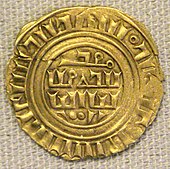County of Tripoli
[1][2] When the Frankish Crusaders, mostly southern French forces – captured the region in 1109, Bertrand of Toulouse became the first count of Tripoli as a vassal of King Baldwin I of Jerusalem.
From that time on, the rule of the county was decided not strictly by inheritance but by factors such as military force (external and civil war), favour and negotiation.
[3][6] On a natural ridge, which he named "Mons Peregrinus" (French: Mont Pèlerin, English: Mount Pilgrim), 3 kilometres (1.9 mi) from Tripoli, Raymond IV (also known as Raymond de Saint-Gilles) began the construction of a large fortress, the Citadel of Tripoli (Arabic: قلعة طرابلس Qalʻat Ṭarābulus), formerly also known as the "Castle of Saint-Gilles" (Arabic: قلعة سان جيل Qalʻat Sān Jīl).
[7] Bertrand of Toulouse, who was supported by Baldwin I of Jerusalem, arrived in the Near East with a substantial army and a large Genoese fleet.
[3] The Muslim position strengthened when the Hashshashin (Nizari Ismailis) forces formed in the Nosairi mountains to the north.
[3] In 1144, in order to increase the county's defences, particularly against Zangi of Mosul, Raymond II gave the Knights Hospitaller large stretches of frontier land along the Buqai'ah plain.
[10] This included the castles of Krak des Chevaliers, Anaz, Tell Kalakh, Qalaat el Felis and Mardabech.
In joining Prince Tancred of Galilee and Count Baldwin II of Edessa at the Battle of Shaizar, their defence of the kingdom was successful.
In 1125, Count Pons of Tripoli marched against the Turks who had again attacked Edessa, this time besieging the town of Azaz.
Pons of Tripoli, Baldwin II and Count Joscelin I of Edessa lured the Turks from Azaz and into an ambush on the plains, where the Turkish forces were defeated.
The Turkish forces, having only recently battled Raymond II at the Siege of Damascus, attacked the castle of Arima (al-Ariymah).
[16] Paul of Segni, Bishop of Tripoli, who was a friend of the Templar Grandmaster, William of Beaujeu, opposed the succession of Bohemond VII.
[16] This action led to indecisive fighting over the following months at Botron, Fort Nephin, Sidon and at sea.
Guy, his brothers, and cousins were imprisoned at Fort Nephin and left to starve; his followers were blinded and the Templars were summarily executed.
In Tripoli, a special non-aristocratic social status had been granted to people from the great mercantile cities of Europe, especially those from the maritime republics of Italy (e.g., Venice).
His mother, Sibylla of Armenia, was discounted in the succession because she was the friend of Bishop Bartholomew of Tortosa, considered an enemy of Tripoli.
Bohemond VII's younger sister, Lucie, established herself at Fort Nephin with the support of the Knights Hospitaller.
[19] Constant infighting, lack of resources, a series of poor harvests, changes to trade routes and the local economy and Muslim and Mongol military pressure led to the decline of the Kingdom of Jerusalem.


